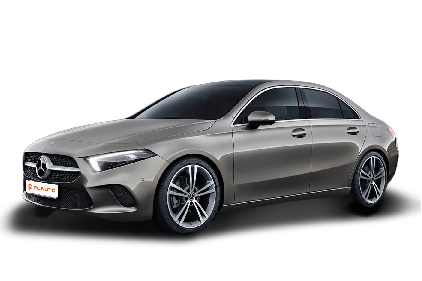Q
Is the Mercedes A-Class economical?
The Mercedes A-Class can be considered quite economical. For instance, the official combined fuel consumption of the A200 Style is 5.4 liters per 100 kilometers, which is relatively fuel-efficient compared to other vehicles in its class. Its 1.3-liter turbocharged engine helps to balance performance and fuel economy. The starting price of the 2021 A200 Style is relatively low at 220,458 Malaysian Ringgit, making it more accessible in terms of initial investment compared to some other Mercedes models.
However, it’s important to keep in mind that factors such as driving habits, road conditions, and maintenance costs can impact overall efficiency. The maintenance costs of Mercedes vehicles typically align with the quality standards of the brand, potentially covering regular servicing, parts replacement, and the use of high-quality lubricants. Nevertheless, considering the advanced safety systems, comfortable interiors, and the brand’s reputation, the Mercedes A-Class strikes a balance between economy and the luxury experience for which the brand is renowned.
Special Disclaimer: This content is published by users and does not represent the views or position of PCauto.
Related Q&A
Q
How much is the cheapest Mercedes 2024?
The cheapest Mercedes-Benz model in Malaysia for 2024 is expected to be the A-Class Sedan, with a starting price of around RM220,000 (exact pricing may vary based on configuration, taxes, or promotional offers). This compact luxury sedan is powered by a 1.3-liter turbocharged engine, available in different tunes producing 136 hp to 163 hp, making it ideal for consumers seeking brand value and urban driving agility. If your budget is tight but you still want to experience Mercedes technology, keep an eye on their Certified Pre-Owned (CPO) program, which typically offers 15%-30% savings. It's worth noting that Mercedes-Benz locally assembles (CKD) some models in Malaysia to reduce costs, such as the C-Class and GLC, but the A-Class is currently still sold as a fully imported (CBU) unit, hence the higher price. German rivals in the same segment like the BMW 2 Series Gran Coupe or Audi A3 are similarly priced but focus on different features, so it's advisable for consumers to test drive and compare based on their needs. Additionally, Mercedes-Benz Malaysia often provides low-interest financing or free service packages, so be sure to check with authorized dealers for the latest promotions before purchasing.
Q
Is the A-Class a family car?
To some extent, the A-Class can be considered a family vehicle. It features a four-door, five-seat layout that provides ample space for small families. The 60:40 split-folding rear seats offer flexibility for accommodating both passengers and cargo. With a fuel tank capacity of 51 liters, it allows for long-distance travel without frequent refueling stops.
Safety is prioritized with multiple airbags, an Anti-lock Braking System (ABS), and Electronic Stability Control, ensuring the safety of the entire family during trips. Inside, the car is equipped with a fully digital instrument cluster, a touchscreen central display, and a premium sound system featuring 10 speakers, providing a comfortable driving experience and entertainment enjoyment.
However, as a compact car, the interior space may not be as roomy as some larger family vehicles. Overall, it combines practicality, safety, and comfort, making it suitable for family use.
Q
Which model of A-Class is the fastest?
Among the models offered, the 2023 Mercedes-Benz A-Class Sedan A250 4MATIC AMG Line is the fastest, boasting a top speed of 250 km/h and an official 0-100 km/h acceleration time of 6.3 seconds. This vehicle features a displacement of 1991 mL and utilizes a turbocharged intake system, with a maximum power output of 224 PS.
Generally speaking, a vehicle's top speed and acceleration times are influenced by various factors, including engine performance, vehicle weight, and the transmission system. The A250 4MATIC AMG Line benefits from a relatively large displacement and a powerful turbocharged engine, giving it a significant advantage in power delivery and enabling faster speed performance. In comparison to other A-Class models, it stands out in terms of dynamic capabilities.
Q
Where is Mercedes A-Class made?
The Mercedes-Benz A-Class is manufactured in Rastatt, Germany. The Rastatt plant is located more than 100 kilometers west of Stuttgart. It primarily produces compact cars, including the new A-Class, the updated B-Class luxury sports tourer, and the compact SUV – GLA. Currently, the plant’s annual production exceeds 200,000 units.
This facility plays a significant role in the production of Mercedes-Benz’s compact car lineup, ensuring that models like the A-Class can meet global market demand. The manufacturing process here adheres to Mercedes-Benz’s high standards of quality and precision, utilizing advanced technology and implementing stringent quality control measures to ensure that the A-Class vehicles that roll off the assembly line meet exceptional performance and quality standards.
Q
What is the top speed of Mercedes A-Class?
The top speeds of different models in the Mercedes A-Class vary, with the A200 model achieving a maximum speed of 230 km/h, while the A250 can reach up to 250 km/h. In addition to engine power and torque, several other factors, including aerodynamic drag coefficient, tire specifications, and suspension tuning influence a vehicle's top speed.
For instance, a powerful engine combined with a low drag coefficient results in reduced air resistance, which is beneficial for achieving higher speeds. Additionally, good tire grip and stable suspension tuning ensure the vehicle’s safety and stability at high speeds, further supporting its ability to reach elevated top speeds.
Q
What is the lifespan of Mercedes engine oil ?
The lifespan of Mercedes engine oil can vary based on several factors. Generally speaking, when using fully synthetic oil, the typical replacement interval is around 10,000 kilometers or one year. For example, the 5W-40 fully synthetic oil used in the Mercedes A-Class follows this replacement schedule. However, this is not an absolute standard, as actual usage should be adjusted according to the vehicle's specific condition and operating environment.
For instance, if a vehicle is frequently driven in high-temperature, high-load, or dusty conditions, the oil may degrade more quickly, necessitating an earlier change. Additionally, if you notice changes in oil viscosity, unusual odors, or significant discoloration, you should consider replacing the oil even if the specified time or mileage has not yet been reached.
Furthermore, the shelf life of unopened leftover oil after servicing is typically one year. Once opened and sealed properly, it’s best to use the oil within six months under ideal storage conditions. The oil that has been poured into the engine has an effective lifespan of about six months.
Q
What is the average fuel consumption of Mercedes A Class?
The Mercedes A-Class offers various models with different fuel efficiency figures. The models equipped with a 1.3T engine have an official combined fuel consumption of 5.4L/100km, while those featuring a 2.0T engine report an official combined fuel consumption of 6.3L/100km. However, real-world fuel consumption can be influenced by driving habits, road conditions, vehicle load, and other factors, which often leads to discrepancies from the official figures.
For instance, some real-world tests and owner feedback indicate that actual fuel consumption might be higher than those official numbers. Understanding these variations can assist potential buyers in making informed decisions by considering their own needs and factoring in fuel economy when selecting a vehicle.
Q
Does a Mercedes A Class have a service book?
The Mercedes A-Class typically comes with a service manual (maintenance handbook). This manual contains essential information regarding vehicle maintenance, including service items, maintenance intervals, and mileage recommendations. It helps owners understand when and what type of servicing their vehicle requires, ensuring that it remains in excellent condition. Vehicle owners can obtain a printed version of the service manual from the dealership where they purchased their car. Additionally, some electronic PDF versions are available for free download to mobile devices, making it convenient for owners to access the information at any time, often obtainable through relevant website links. Familiarizing themselves with this information enables vehicle owners to effectively schedule maintenance, thus prolong the lifespan of their cars.
Q
Is Mercedes A-Class expensive to fix?
The maintenance costs for the Mercedes A-Class are relatively high, positioning it at a medium level among luxury brands. As a luxury brand, Mercedes vehicles feature high standards in design, materials, and manufacturing processes, which contributes to higher prices for certain parts and repair services. A basic service, including oil and filter changes, costs approximately 900 Malaysian Ringgit, while a three-year, 60,000-kilometer maintenance service amounts to around 8,831 Malaysian Ringgit (excluding labor fees).
Maintenance services are divided into A service and B service. The A service mainly involves an oil change and oil filter replacement, costing between 858 and 1,008 Malaysian Ringgit, whereas the B service is priced at around 1,200 Malaysian Ringgit. The cost of maintenance varies depending on driving mileage, with services at 10,000 kilometers and 50,000 kilometers being less expensive, while the service at 60,000 kilometers is the most costly. However, repair costs can differ based on the specific service, scope of repair, and regions. Furthermore, Mercedes has a comprehensive after-sales service network and offers various service plans, which can help vehicle owners reduce maintenance costs to some extent.
Q
Which model of Mercedes A-Class is the best?
Each variant of the Mercedes A-Class has its unique advantages, making it difficult to determine which model is the "best." The A200 Progressive Line is priced at RM 238,888, featuring a 1.3L engine with an official 0-100 km/h acceleration time of 8.1 seconds and a combined fuel consumption of 5.4L/100km, making it suitable for those who value a smooth driving experience and low fuel consumption.
On the other hand, the A250 4MATIC AMG Line is priced at RM 263,888 and boasts a 2.0L engine with a maximum output of 224 PS and a 0-100 km/h acceleration of just 6.3 seconds. This model offers robust performance, appealing to those with high demands for power and a desire for a thrilling driving experience.
If your budget is limited, consider the older model, such as the 2021 A200 Progressive Line, which is available at a more affordable price of RM 220,458. Conversely, if your budget allows and you seek high performance, the new A250 4MATIC AMG Line would be an excellent choice. Ultimately, the best model depends on individual factors such as budget, performance requirements, and fuel consumption preferences.
Popular Cars
Model Year
Car Compare
Car Photo
Latest Q&A
Q
Does the 2019 Golf GTI have a timing belt or chain?
The 2019 Golf GTI uses a timing chain instead of a timing belt—a design that offers better durability and lower maintenance costs. Typically, a chain lasts as long as the engine itself and rarely needs replacement, whereas a belt requires inspection or replacement every 60,000 to 100,000 km. If neglected, a worn belt can snap and cause severe engine damage.
VW’s EA888 engine family has long relied on chain-driven systems, which are relatively quiet and highly reliable. That said, it’s crucial to periodically check the tensioner’s condition. Some earlier models experienced timing issues due to tensioner design flaws, but this was addressed in the 2019 version.
For performance enthusiasts, a chain system handles high-revving stress better, making it a common choice for hot hatches like the GTI. For daily driving, just stick to VW 50400/50700-spec oil as recommended in the manual—proper lubrication keeps the chain system healthy long-term.
One heads-up: If you hear noticeable metallic rattling near the front of the engine, have the guides or tensioner inspected ASAP. Unlike the telltale belt squeal before failure, this noise is a classic sign of chain-related wear.
Q
What is the recall on the 2019 GTI?
The 2019 Volkswagen Golf GTI was subject to a safety recall addressing two potential issues. First, the fuel pump control unit software could malfunction, potentially causing engine stalling in rare cases. Second, some vehicles might have rear suspension stabilizer link bolts that weren't tightened to specification, posing a loosening risk. Owners can visit authorized dealers for free software updates or bolt retightening.
These proactive recalls demonstrate Volkswagen's commitment to safety. Dealers often handle outstanding recall items during routine maintenance.
For performance-oriented models like the GTI, it's wise to go beyond recall checks. Pay close attention to the turbo system, DSG transmission fluid, and brake wear—these components endure more stress during spirited driving. If warning lights appear or you notice unusual noises, get a professional inspection promptly. Keeping the car in top shape ensures you can fully enjoy its dynamic capabilities.
Q
Does the 2019 GTI require premium gas?
The 2019 GTI does recommend using high-octane fuel (typically RON 95 or above). Its 2.0L turbocharged engine has a relatively high compression ratio, and premium gas ensures optimal performance while reducing knock risk. It also helps maintain engine cleanliness and long-term reliability.
While the car may tolerate lower-octane fuel (like RON 92), you’d see slightly reduced power output and fuel efficiency. Over time, it could also affect engine longevity. Turbocharged engines are particularly sensitive to octane ratings since turbos generate higher heat and pressure—high-octane fuel handles these conditions better.
Mixing different fuel grades occasionally won’t hurt, but sticking to the manufacturer’s recommendation is ideal. Also, periodic fuel additive treatments can help clean carbon buildup, especially for direct-injection engines.
One more thing: even with the same octane rating, fuel additive packages vary by brand. So, picking a reputable gas station matters too.
Q
How long will a 2019 GTI last?
The lifespan of a 2019 GTI largely depends on maintenance and driving habits. With regular oil changes, transmission fluid replacements, and avoiding aggressive driving, it can easily clock over 200,000 kilometers—or even more. Its 2.0T engine and DSG gearbox are proven combos, and as long as you stick to the factory service schedule, mechanical reliability won’t be an issue.
Just keep in mind: turbocharged engines demand extra care. Always use the right spec full-synthetic oil and monitor the cooling system. Climate plays a role too—hot, humid conditions mean paying extra attention to rubber seals and electronics. Every 50,000 km, have the timing chain and high-pressure fuel pump inspected (key items for turbos).
Driving style matters. Don’t redline it constantly, and let the engine warm up properly after cold starts. Rustproofing helps long-term durability, so regular underbody washes are smart. Nail these details, and this car’s built to last.
Q
How fast is the 2019 GTI?
The 2019 GTI truly delivers when it comes to performance. Under the hood lies a punchy 2.0-liter turbocharged four-cylinder, churning out 228 horsepower and 350 Nm of torque. Whether you opt for the engaging 6-speed manual or the lightning-fast 7-speed DSG, this hot hatch rockets from 0-100 km/h in just 6.3 seconds, with an electronically limited top speed of 250 km/h.
What really sets the GTI apart is its razor-sharp handling. The sport-tuned suspension and electronic differential lock work together to deliver precise steering and rock-solid cornering stability. It’s the perfect blend of everyday practicality and proper driver’s car thrills—a well-rounded hot hatch in every sense.
For enthusiasts, the GTI’s tuning potential is massive. Many owners go for ECU remaps or intake/exhaust upgrades to squeeze out even more power. Just remember to keep things street-legal—safety and compliance should always come first. Around here, these pocket rockets have a solid following, and it’s easy to see why.
View MoreRelated News

Mercedes-Benz invests in an autonomous driving technology company under Geely named Qianli
AshleySep 25, 2025

Benz launches its first car equipped with solid-state batteries, capable of traveling 1,205 kilometers on a full charge
WilliamSep 10, 2025

Mercedes-Benz electric vehicle design language will also undergo a major change to respond to BMW Neue Klasse.
JamesSep 9, 2025

Mercedes-Benz CLA Electric Opens for Pre-Orders with Over 700km Range
AshleyAug 14, 2025

Mercedes-Benz Unveils Bold Plan: 18 New Models by 2026
Kevin WongAug 6, 2025
View More


















Pros
Cons